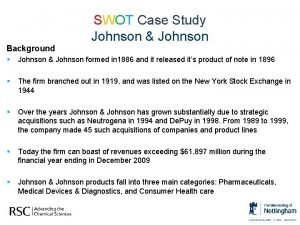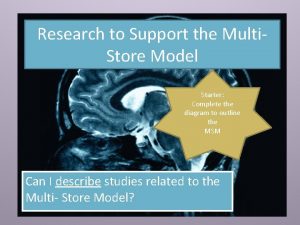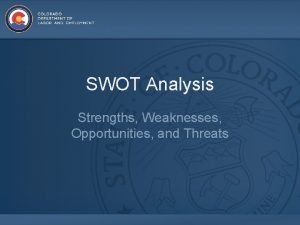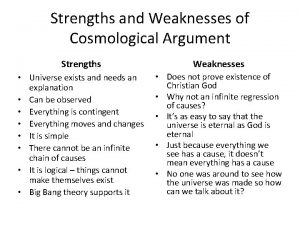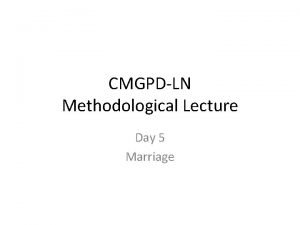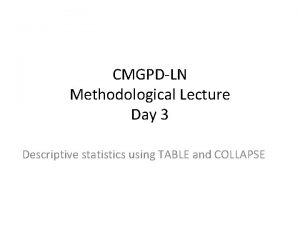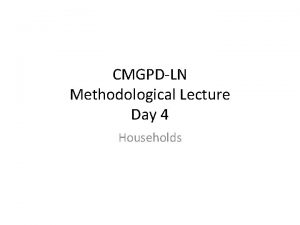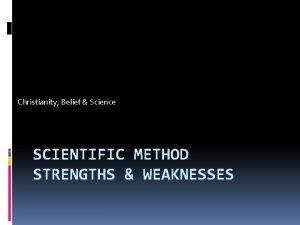CMGPDLN Methodological Lecture Day 2 Strengths and Weaknesses

















- Slides: 17

CMGPD-LN Methodological Lecture Day 2 Strengths and Weaknesses of the CMGPD-LN

Historical population databases • • Parish registers Genealogies Censuses Household registers

Table A. 1. Comparison of features of sources for historical demography Parish registers Longitudinal X Individuallevel X Vital statistics Censuses X X Detail on households Genealogies Household registers X X X Geographic specificity X X Complete community X X X Population at risk Timing of vital events X X X

CMGPD-LN Relative Strengths • Household and village of residence – Not available in genealogies, parish registers • Longitudinal – Not available in censuses • Complete recording of the at-risk population – Not available in parish registers • Time-depth/Multigenerational – Not available in most household registers • Kinship – Genealogies typically only record a single descent group • Prospective – Genealogies are retrospective






CMGPD-LN Limitations • Omission of boys who died in infancy and early childhood – Can’t really do infant or early child mortality – Underestimate fertility • Omission of daughters • No non-state occupations, or landholding – Landholding will be able in Shuangcheng (CMGPDSC)


Average numbers of boys and girls born in next 3 years to married men aged 15 -50

CMGPD-LN Limitations • Missing registers – Event-history analysis limited to registers for which immediately following register is also available • Unrecorded deaths – A small % of individuals who were probably dead, were carried on alive from register to register as if they were alive – Creates problems at advanced (80+) ages


Using the Data RECORD_NUMBER • RECORD_NUMBER identifies the same observation across the different datasets • Use as the basis for one-to-one merge local cmgpd_ln_location ". . CMGPD-LN from ICPSRICPSR_27063“ use "`cmgpd_ln_location'DS 000127063 -0001 -Data“ merge 1: 1 RECORD_NUMBER using "`cmgpd_ln_location'DS 000327063 -0003 -Data"

Using the Data RECORD_NUMBER • If the merged datasets won’t fit into memory, make use of options on use and merge to load specific variables use RECORD_ID YEAR SEX using "`cmgpd_ln_location'DS 000127063 -0001 -Data“ merge 1: 1 RECORD_NUMBER using "`cmgpd_ln_location'DS 000327063 -0003 -Data“, keepusing(NON_HAN_NAME) tab YEAR if SEX == 2, sum(NON_HAN_NAME)

Using the Data Missing Values • Following standard practice, missing values are coded as -98 or -99 – -98 is structural missing – -99 is missing • These are not the same as STATA missing, so observations will not be excluded automatically • Especially in regressions, computations of means, etc. , either manually exclude these, or recode to force exclusion – recode ZHI_SHI_REN -99 -98=. or – summ ZHI_SHI_REN if ZHI_SHI_REN != -98 & ZHI_SHI_REN != -99
 Day 1 day 2 day 3 day 4
Day 1 day 2 day 3 day 4 Johnson and johnson strengths and weaknesses
Johnson and johnson strengths and weaknesses Marks and spencer strengths and weaknesses
Marks and spencer strengths and weaknesses American and british strengths and weaknesses
American and british strengths and weaknesses Strengths and weaknesses of the union and confederacy
Strengths and weaknesses of the union and confederacy North and south strengths and weaknesses chart
North and south strengths and weaknesses chart Glanzer and cunitz strengths and weaknesses
Glanzer and cunitz strengths and weaknesses Mbti strengths and weaknesses
Mbti strengths and weaknesses Hilda taba model of curriculum development
Hilda taba model of curriculum development Pattern of strengths and weaknesses worksheet
Pattern of strengths and weaknesses worksheet Token economy in psychology
Token economy in psychology Articles of confederation characteristics
Articles of confederation characteristics Teacher input examples
Teacher input examples Manpower strengths and weaknesses
Manpower strengths and weaknesses 3 strengths and weaknesses
3 strengths and weaknesses Marketing manager strengths and weaknesses
Marketing manager strengths and weaknesses Strengths and weaknesses examples
Strengths and weaknesses examples Zeus's weakness
Zeus's weakness

